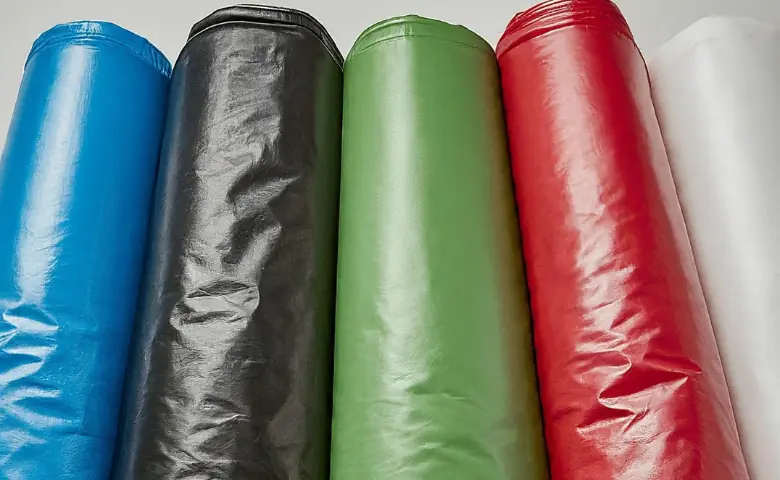
Why different colored garbage bags are used for garbage bins? Proper waste management is essential for maintaining cleanliness, hygiene, and environmental sustainability. In Canada, a diverse range of garbage bins are utilized to facilitate efficient waste disposal and recycling processes. Having knowledge about various types of garbage bins available across the country can help individuals, communities, and organizations make informed decisions about waste management practices.
In this blog, we will shed insight into the different types of garbage bins, and garbage trash bags commonly used in Canada, their features, and their significance in waste management systems.
General Waste Bins
General waste bins, also known as trash bins or garbage cans, are ubiquitous in Canadian cities, towns, and communities. These bins are typically designed for disposing of non-recyclable household waste, such as food scraps, packaging materials, and other items that cannot be recycled or composted. General waste bins come in various sizes, shapes, and materials, including plastic, metal, and durable composite materials. They are often accompanied by lids to contain odors and prevent scavenging by animals.
Recycling Bins
Recycling bins play a crucial role in diverting recyclable materials from landfills and promoting sustainable waste management practices. In Canada, recycling bins are commonly used to collect materials such as paper, cardboard, glass, plastic bottles, and aluminum cans. These bins are usually color-coded or labeled to indicate the types of materials that should be placed inside them. Municipalities across Canada provide recycling programs and collection services to encourage residents and businesses to participate in recycling efforts.
Composting Bins
Composting bins are specifically designed for collecting organic waste materials, such as food scraps, yard trimmings, and biodegradable materials. Composting bins facilitate the decomposition of organic matter through natural processes, resulting in the production of nutrient-rich compost that can be used to enrich soil and promote plant growth. In Canada, composting bins are increasingly being implemented in homes, schools, businesses, and community gardens as part of efforts to reduce organic waste sent to landfills and mitigate environmental impacts.
Hazardous Waste Bins
Hazardous waste bins are utilized for the safe disposal of materials that pose potential risks to human health and the environment if improperly handled or disposed of. Examples of hazardous waste include batteries, fluorescent light bulbs, electronic waste (e-waste), chemicals, paints, solvents, and pharmaceuticals. In Canada, specialized hazardous waste collection programs and facilities are available to ensure the proper management and disposal of hazardous materials, preventing contamination and pollution.
Green Bins (Organics)
Green bins, also known as organics bins or compost bins, are dedicated containers for collecting organic waste materials suitable for composting. These bins are commonly used in municipalities with organics recycling programs, where residents separate food scraps, yard waste, and other organic materials from general waste for composting purposes. Green bins are typically provided by local governments or waste management authorities and are an integral component of efforts to divert organic waste from landfills and reduce greenhouse gas emissions.

Why There are Different Colored Garbage Bags?
There are two main reasons why there are colored garbage bags uses:
- Waste Sorting and Recycling: The most common use of colored garbage bags is to facilitate waste sorting and recycling. Different colors designate different types of waste, making it easier for people at home and workers at waste processing facilities to separate recyclables, compostable materials, and general trash. This reduces contamination in recycling and compost streams, ultimately making the waste management process more efficient.
- Safety and Awareness: Some colored bags indicate the presence of hazardous materials, requiring special handling procedures. For instance, red bags might be used for medical waste or biohazards, while yellow could signify hazardous chemicals. This color-coding helps raise awareness and ensures these materials are disposed of safely.
Here’s a quick breakdown of common colored garbage bags uses:
Black garbage bags – They are generally used for regular, non-recyclable household trash like plastic packaging, food wrappers, and tissues.
Green garbage bags – ideally used for compostable materials like food scraps, yard trimmings, and coffee grounds. These organic materials can be broken down and turned into nutrient-rich soil.
Yellow garbage bags – Typically used for potentially hazardous waste, but the exact meaning can vary depending on your region. It’s always best to check with your local waste management provider.
Blue garbage bags – Usually designated for recyclable materials such as paper, cardboard, plastic bottles, and metal cans. This color coding helps streamline the recycling process by allowing for easier sorting at home and in waste management facilities.
Red garbage bags – Used in healthcare facilities for the safe disposal of bio-hazardous waste, including items like bodily fluids, tissues, cultures, and potentially infectious materials used in research.
White garbage bags – Similar to clear bags, but offer slightly less transparency. They might be used for a cleaner look while still allowing some visibility of the contents. However, unlike some colored bags, white doesn’t typically signify a specific waste type and may be used for regular trash depending on the region.
Orange garbage bags – In some regions, orange signifies heavy-duty construction or yard waste bags, ideal for bulky or tough materials. Whereas in few regions orange trash bags are use for specific types of recyclables, such as clothing, shoes, or toys, in their “simple recycling” programs.
Conclusion:
In Canada, garbage bins are employed to facilitate effective waste management and recycling initiatives. From general waste bins to recycling bins, composting bins, hazardous waste bins, and green bins. Each serves a specific purpose in diverting waste from landfills, conserving resources, and promoting environmental sustainability.
By understanding the different types of garbage bins available and participating in recycling and composting programs, individuals and communities can contribute to reducing waste generation and minimizing the environmental impact of waste disposal practices.
To align with environment, Ideal Packaging and supplies, a leading garbage bags manufacturer also provide various colored garbage bags for effective waste management in Canada. To inquire or bulk order, kindly contact today.
